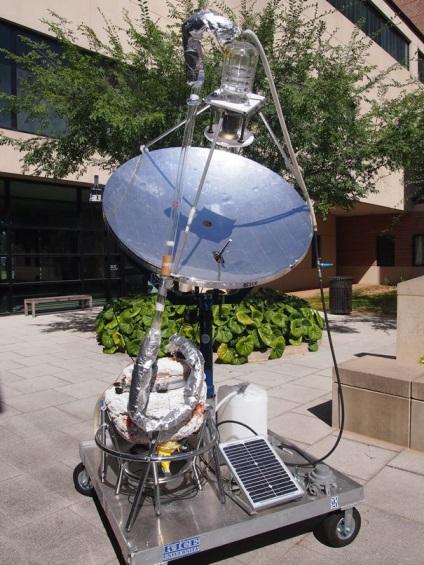Light absorbing particles generate steam in cold water using sunlight
9 September 2013
Light absorbing nanoparticles dispersed in water can generate steam from sunlight with remarkable efficiency and without needing to boil the whole container of water (see video below).
The revolutionary technology, developed at Rice University in the US, has been applied to build solar powered autoclaves to sterilise medical instruments and also human and animal waste.
Prototypes of the devices, which need no electricity or fuel, were the topic of one of the keynote addresses at the opening of the 246th National Meeting & Exposition of the American Chemical Society (ACS) in Indiana.
The particles absorb sunlight which generates a steam bubble around each particle. The particles rise to the surface of the water and release the steam. “Nanoheaters generate steam at a remarkably high efficiency,” said Dr Naomi Halas of Rice University. “More than 80% of the energy they absorb from sunlight goes into production of steam. In the conventional production of steam, you would have to heat the entire container of water until it boils, with the bubbles rising to the top to release steam. With nanoheaters, less than 20% of the energy heats the neighbouring liquid.”
Halas and colleagues have prototypes of two solar steam machines. One is the autoclave for sterilizing medical and dental instruments. The second is an autoclave for disinfecting human and animal wastes, which are another major source of disease transmission in developing countries and other resource-limited areas. The prototype autoclaves consist of a dish-like mirror that focuses sunlight into a container of water with the nanoheaters (see below).

Tests showed that the prototype autoclaves produced steam at temperatures ranging from 239 to 270°F (115-132°C). Steam production adequate for sterilization began within about 5 minutes. It continued for periods of time long enough to sterilize liquid and solid materials placed inside the device, consistent with US Food and Drug Administration sterilisation guidelines. The heat and pressure produced by the steam was great enough to kill the most heat-resistant living microbes, and also viruses and the tough spores that microbes form to survive hostile environmental conditions.
Dr Halas added, "It is completely off-grid, uses sunlight as the energy source, is not that large, kills disease-causing microbes effectively and relatively quickly and is easy to operate. This is an incredibly promising technology.”
The technology could be expanded to provide steam for direct use in purifying dirty or salty water for drinking and cooking — with the solar-generated steam simply allowed to condense into pure distilled water. Possibilities also exist for adapting the technology to produce steam to spin small electric turbines to generate electricity.
Dr Halas recently formed a company that is working on moving the devices from the prototype stage to commercial products. She and her collaborators are seeking ways to make them more rugged and at a more reasonable cost. They are also exploring more applications for the technology.
Video of Dr Halas explaining the technology